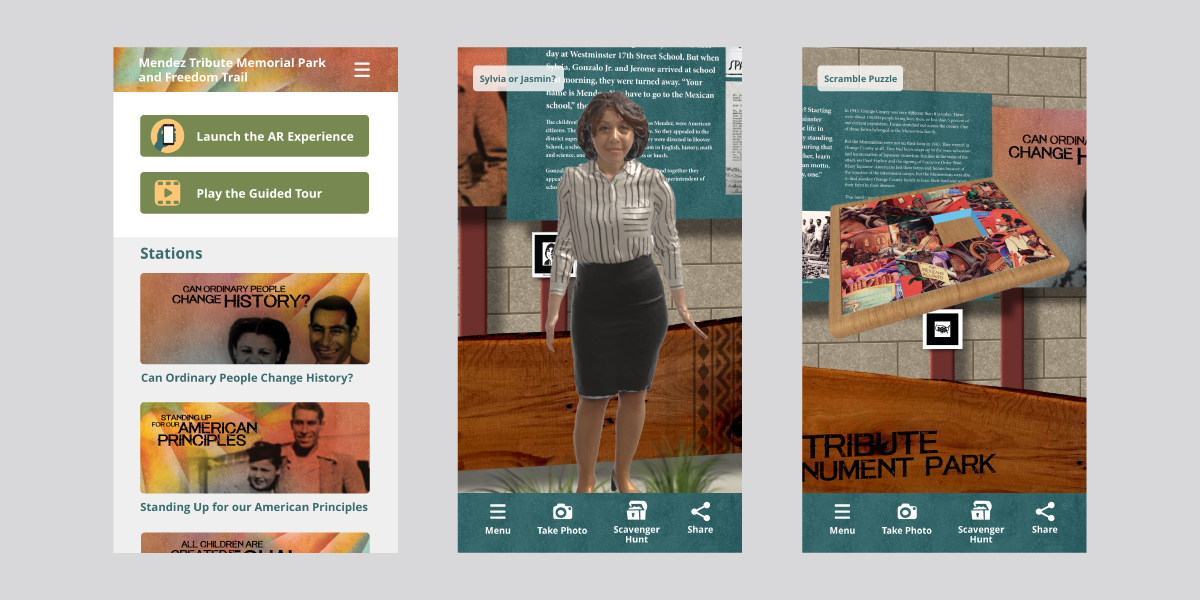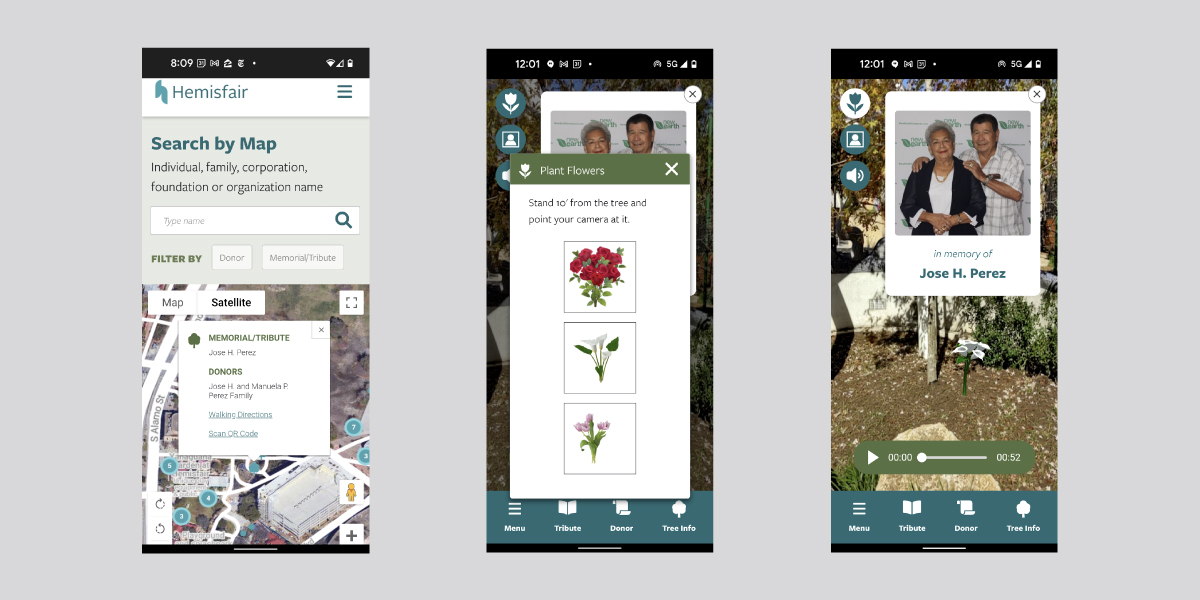by Steve Kokotas, MIG Director of Technology Services
You’ve probably heard of kids playing “Pokémon Go,” chasing animated characters “present” in the real world. Or maybe you’ve used the Ikea app that lets you place true-to-scale 3D models in your very own living room. Embracing this new technologies in parks can help folks of all ages engage with each other, learn about the place they’re physically in and, hopefully, develop even deeper connections with the outdoors as they play in it.
Wondering about mixed reality (MR) versus augmented reality (AR) versus virtual reality (VR)?
All of them use a series of cameras, sensors, scanned markers or codes, and often AI-enhanced technology to process data about a space and use that information to create digitally enhanced experiences.
Mixed reality is in the middle of the immersive media spectrum. On one side, augmented reality, like Pokémon Go, overlays digital content on top of the real environment that you’re in. On the other side, virtual reality completely replaces your existing environment with a new, computerized space; you’re usually wearing a headset and goggles, and it feels like you are completely inside that digital environment (heck you can even fly in it!).
Mixed reality blends elements of AR and VR, allowing you to see the digital augmentation in your environment and also interact with it. For example, you might use hand gestures to move a piece of digital content around.
Let’s take a look at two examples of mixed and augmented reality that you could apply in your own parks: The Mendez Monument Tribute Park and Freedom Trail in southern California, and the Hemisfair Park Tree Donor program in San Antonio, Texas.
Mendez Park honors Gonzalo and Felicitas Mendez. In 1947, the two parents led an educational civil rights battle that changed California forever. Their daughter, Sylvia Mendez, was the catalyst for their efforts. Their landmark desegregation case set a legal precedent for the famous Brown v. Board of Education case, paved the way to meaningful integration and public school reform, and set the stage for the American civil rights movement. The urban park is a partnership between the City of Westminster and the Orange County Department of Education.
The park and interpretive trail will have sculptures and art pieces created by local artist Ignacio Gomez, a park plaza with seating, and interpretive panels.
And then the fun begins.
The park is chock-a-block full of AR and other interactive technology. The essence of AR is that your device—phone or tablet—uses its camera to recognize objects in the real world and then renders computer graphics to the same 3D space, creating the illusion that virtual objects are in the same physical space with you. Throughout the park, visitors will find AR targets, icons that instruct their phone to activate an AR experience.
A scavenger hunt sends kids through the park looking for educational items. A “newspaper” from Feb 20, 1946 is suddenly right in front of you as a 3D image you can zoom in on and flip to read the Federal court ruling ending the segregation of Latino school children. A local wall mural depicting segregation in Westminster in 1947 becomes an interactive slide puzzle. Sylvia Mendez, herself, will talk to you—you can even have someone take your photo standing with her. And, Jasmine, a local high school student, becomes a “character” guide providing 90-second educational bites about the constitutional significance of the court ruling. There are several other AR interactions such as a celebratory graduation cap featuring a confetti burst of color and an interactive spinning carousel playfully highlighting the six American guiding principles.
The Orange County Department of education is developing age-appropriate curriculum and planning numerous field trips. There are opportunities to tie in local businesses, too. For example, kids who complete the scavenger hunt could show their phones to a nearby store or yogurt/ice cream shop for prizes. The web app and the entire park and AR experience will be provided in English, Spanish and Vietnamese. The park and web app are slated to launch to the public this summer!
Web apps function within the device’s browser and do not need to be downloaded or installed which means park users can conveniently and quickly engage with the app. Web apps are easier and less expensive to maintain since they use a single codebase regardless of the device being used. This means they are also less expensive to maintain and update than mobile apps because developers don’t need to create and maintain separate versions for Google and Apple phones. And, “progressive web apps” can work offline–without an internet connection—and they load extremely quickly. In many ways, the user convenience and cost and maintenance advantages of web apps make them a better choice for civic, park, exhibit, wayfinding, and urban planning applications.
About 1,300 miles east, a simpler AR experience—but very effective park fund raising effort—is underway. Hemisfair Park in San Antonio sits on the 92-acre site of the 1968 World’s fair—which had long been underused. The City hopes it will become one of the world’s great public spaces. It already boasts a fantastic park, the Yanaguana Garden Play Area, and the site can offer much more.
The goal now is to plant about 250 mature trees with well-developed canopies for shade in other parks that are being developed on the site. Mature trees offer immediate benefits, but they also have immediate costs. Like $7,000 per tree. The new Tree Recognition App encourages community members to donate for trees by providing a memorable digital experience as a tribute to loved ones, companies and organizations.
Once a tree is planted, visitors can scan QR (quick response) codes on the tree or on wayfinding signs to launch the web app. They can then search for donors using a name or do a map search, which provides walking directions right to the tree. When they reach the tree, visitors find an AR scene that includes the ability to find more information about the type of tree, listen to an audio recording made by the donor, and read more about and see the person or organization that’s being honored. The entire experience is in English and Spanish.
And to become part of the landscape itself, visitors can “plant” virtual flowers at the tree. Juggle the phone just right, and a companion can snap a photo of you holding virtual flowers in front of the tree!
About 95 trees are already online. While the AR experience is best when you’re actually in the park, you can also see on your web browser what park visitors would see when they scan the QR code (works best on a phone or tablet).
The mixture of digital and real-world environments promises exciting things for the future. The technology adds another layer of interaction to already rich park experiences. It’s educational, it’s fun, it’s outdoors—and it lures younger visitors into spending more time with family, friends and nature.
Steve Kokotas, MIG Principal and Director of Technology Services
When he was a kid, Steve Kokotas was fascinated with cities. When he was in college, he discovered he could actually study urban planning—he was thrilled! His first full-time work was at USRobotics during the “post-punk new wave” ’80s and the birth of Wired magazine. That’s when he saw the power of data communications and the internet to annihilate space and accelerate information sharing. For Steve, information sharing is not simply about providing access to information; it’s also about broadening what counts as useful information, and who creates, owns and distributes information in the Informational City of the future. Steve has over 20 years of experience developing a wide range of civic, government and urban technology projects, resulting in award-winning web applications and digital tools and services. His projects include specialized database-driven web applications, highly-customized public information systems, mission-critical public agency data warehouses, and web-based educational games, animations, data visualizations and extended reality apps, typically provided as software as a service.


